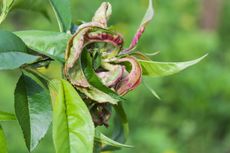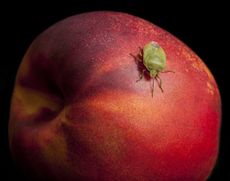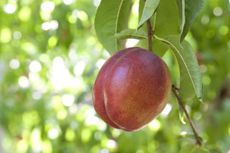Growing Nectarine Fruit Trees: Learn About The Care Of Nectarine Trees


Nectarines are a delicious, summer-growing fruit with an autumn harvest, similar to peaches. They're usually a little smaller than the average peach and have a smooth skin. Uses of nectarines are the same as those of peaches too. They can be eaten fresh, baked into pies and cobblers, and are a sweet, tasty addition to a fruit salad. Let's learn more about how to grow nectarines.
Where Do Nectarines Grow?
If you live in USDA Hardiness Zones 6 to 8 and have a place for a small orchard, or even a single tree, you might consider growing nectarine fruit trees. With the proper care of nectarine trees, they can grow successfully in other areas. Care of nectarine trees in more southern areas includes diligent watering during hot seasons.
Like peaches, new varieties of nectarines are self-fruitful, so you can grow a single tree and have fruit production without a pollinator. Your local county extension office can answer where do nectarines grow in your area and when the steps for care should be performed.
Seasonal Nectarine Tree Care
For any successful fruit crop, a good deal of planning and maintenance is necessary. This is true for care of nectarine trees. Nectarine tree care requires certain steps in each season for the optimum crop. Care of nectarine trees in spring includes several applications of fungicide spray to prevent brown rot.
One to three applications are standard as a part of nectarine tree care, but in rainy areas or seasons, more applications may be necessary. Nectarine tree care in late spring or summer includes applications of nitrogen fertilizer.
You can use urea, rotted manure, or chemical fertilizer and water in well. Young trees need half as much fertilization as older, mature trees. When growing nectarine trees, practice will familiarize you with which applications work best in your nectarine orchard.
Another summer chore, like that with peaches, is thinning fruits from growing nectarine fruit trees. Thin marble sized nectarines to 6 inches (15 cm.) apart for larger nectarines and less breakage of limbs from the weight of growing fruits. Limbs should also be thinned during winter dormancy. This helps control breakage and encourages more fruit production.
Gardening tips, videos, info and more delivered right to your inbox!
Sign up for the Gardening Know How newsletter today and receive a free download of our most popular eBook "How to Grow Delicious Tomatoes."
Another essential element of pruning is leaving only a single trunk on growing nectarine fruit trees. Keep the area beneath the tree weed free within a 3 foot (1 m.) span. Apply organic mulch 3 to 4 inches (8-10 cm.) deep; don't put mulch up against the trunk. Remove leaves from the ground after they've fallen in autumn to avoid disease.
A copper spray will be needed in fall to prevent shot hole fungus. Learning how to grow nectarines is a worthwhile gardening chore. Fresh fruit from your abundant harvest that is not used immediately can be canned or frozen.

Becca Badgett was a regular contributor to Gardening Know How for ten years. Co-author of the book How to Grow an EMERGENCY Garden, Becca specializes in succulent and cactus gardening.
-
 "My Worst Mistake" – Gardeners Share 10 Hard-Learned Lessons
"My Worst Mistake" – Gardeners Share 10 Hard-Learned LessonsGardeners never stop learning, and sometimes our mistakes are the best teachers. But why not save time and heartache by learning from other gardeners' failures?
By Melanie Griffiths
-
 Crops for Urban Growing: 8 Edible Plants For Urban Gardens
Crops for Urban Growing: 8 Edible Plants For Urban GardensUrban edible gardening lets your yard do double duty of beauty and practicality. Have fun combining edible plants with ornamentals.
By Teo Spengler
-
Panamint Nectarine Fruit: Caring For Panamint Nectarine Trees
Panamint nectarine trees are very adaptable for home gardens and produce fruit with an excellent flavor. For more information about Panamint nectarine fruit, plus tips on caring for Panamint nectarines, the following article will help.
By Teo Spengler
-
Southern Belle Nectarines: Learn About Southern Belle Tree Care
If you love peaches but don’t have a landscape that can sustain a larger tree, try growing a Southern Belle nectarine. With its fairly diminutive height, the nectarine ‘Southern Belle’ can be container grown easily. Learn more about this fruit tree in the following article.
By Amy Grant
-
 Nectar Babe Nectarine Info – Growing A Nectarine ‘Nectar Babe’ Cultivar
Nectar Babe Nectarine Info – Growing A Nectarine ‘Nectar Babe’ CultivarAccording to Nectar Babe nectarine information, these are natural dwarf trees, but grow full-size, luscious fruit. You can start growing Nectar Babe nectarines in containers or in the garden. Click here for info on these unique trees plus tips on planting.
By Teo Spengler
-
 Harko Nectarine Care: How To Grow A Harko Nectarine Tree
Harko Nectarine Care: How To Grow A Harko Nectarine TreeThe Harko nectarine is a Canadian variety high on taste and cold tolerant. If you want to grow this nectarine tree, it’s important to have some facts at your fingertips. Click here for information about growing Harko nectarines and tips about Harko nectarine care.
By Teo Spengler
-
 Arctic Rose Nectarine Care: What Is An Arctic Rose Nectarine
Arctic Rose Nectarine Care: What Is An Arctic Rose NectarineIf you are considering growing peaches or nectarines in a backyard orchard, Arctic Rose white nectarine is a great place to start. Click on the following article for information about this interesting cultivar, plus tips on Arctic Rose nectarine care.
By Teo Spengler
-
 Diseases Of Nectarines: How To Spot Common Nectarine Diseases
Diseases Of Nectarines: How To Spot Common Nectarine DiseasesNectarine disease symptoms may not be readily apparent, and you may have to do some serious observation to locate issues. Others are visually evident and not hard to identify. If your nectarine tree is looking or performing differently than in years past, this article can help.
By Becca Badgett
-
 Bugs That Eat Nectarines – Tips For Controlling Nectarine Pests In Gardens
Bugs That Eat Nectarines – Tips For Controlling Nectarine Pests In GardensNectarines and peaches are often used interchangeably in cooking. Not surprisingly, both often face the same pests in the garden. Controlling nectarine pests in the home orchard will help to maintain plant vigor and prevent future pest problems. Learn more here.
By Tonya Barnett
-
 Nectarine Tree Not Fruiting – How To Get Fruit On Nectarine Trees
Nectarine Tree Not Fruiting – How To Get Fruit On Nectarine TreesGetting no fruit on the nectarine trees? If there are no obvious diseases or insect pests, why is the nectarine tree not fruiting? There are quite a few reasons for a fruitless nectarine tree. Find out how to get fruit on nectarine trees in this article.
By Amy Grant